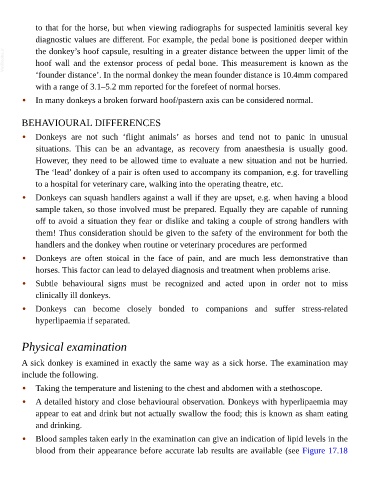Page 1040 - The Veterinary Care of the Horse
P. 1040
to that for the horse, but when viewing radiographs for suspected laminitis several key
diagnostic values are different. For example, the pedal bone is positioned deeper within
VetBooks.ir the donkey’s hoof capsule, resulting in a greater distance between the upper limit of the
hoof wall and the extensor process of pedal bone. This measurement is known as the
‘founder distance’. In the normal donkey the mean founder distance is 10.4mm compared
with a range of 3.1–5.2 mm reported for the forefeet of normal horses.
• In many donkeys a broken forward hoof/pastern axis can be considered normal.
BEHAVIOURAL DIFFERENCES
• Donkeys are not such ‘flight animals’ as horses and tend not to panic in unusual
situations. This can be an advantage, as recovery from anaesthesia is usually good.
However, they need to be allowed time to evaluate a new situation and not be hurried.
The ‘lead’ donkey of a pair is often used to accompany its companion, e.g. for travelling
to a hospital for veterinary care, walking into the operating theatre, etc.
• Donkeys can squash handlers against a wall if they are upset, e.g. when having a blood
sample taken, so those involved must be prepared. Equally they are capable of running
off to avoid a situation they fear or dislike and taking a couple of strong handlers with
them! Thus consideration should be given to the safety of the environment for both the
handlers and the donkey when routine or veterinary procedures are performed
• Donkeys are often stoical in the face of pain, and are much less demonstrative than
horses. This factor can lead to delayed diagnosis and treatment when problems arise.
• Subtle behavioural signs must be recognized and acted upon in order not to miss
clinically ill donkeys.
• Donkeys can become closely bonded to companions and suffer stress-related
hyperlipaemia if separated.
Physical examination
A sick donkey is examined in exactly the same way as a sick horse. The examination may
include the following.
• Taking the temperature and listening to the chest and abdomen with a stethoscope.
• A detailed history and close behavioural observation. Donkeys with hyperlipaemia may
appear to eat and drink but not actually swallow the food; this is known as sham eating
and drinking.
• Blood samples taken early in the examination can give an indication of lipid levels in the
blood from their appearance before accurate lab results are available (see Figure 17.18

